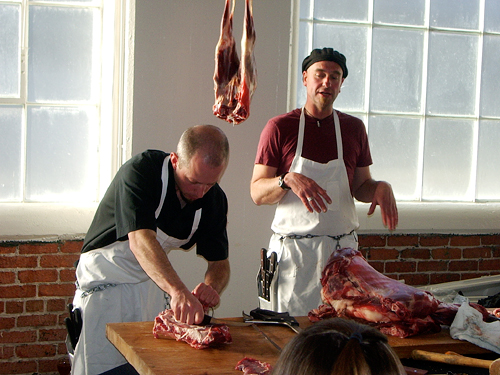Eight weeks later, they were shepherding 50 people up four flights of stairs into a Dogpatch photo studio, transformed into a dining room with the help of green events planner Sadie Waddington of One Big Fish Events. Using her usual prep space at La Cocina, with last-minute staging furiously organized in the studio's tiny galley kitchen, Chef Stephanie created a five-course meal featuring the products of a host of like-minded local suppliers, from strawberries grown at the unionized, organic Swanton Berry Farms near Santa Cruz to beers made by newbie brewer Patrick Horn at Soma's Pacific Brewing Laboratories.
On the plate, the goat was great, from a deep, richly flavored mushroom, liver, and kidney pâté to a black bean and chipotle chile and seared slices of leg (tough and hard to cut, but worth the chew) and a more succulent braised shoulder over polenta and peas. The meat was sweet, not gamy at all, from animals raised at Long Ranch in Manteca, pasture grown and finished on alfalfa. But the real draw? Not the dinner, but the show.
As guests sipped from wine glasses filled with Pacific Brewing Lab's Rough Wooing (a big Scottish-style ale smoothed out with maple syrup, jaggery, and sweet spices), Dave broke down the display goat, first sawing it half, then methodically dividing it from ribs to loin, explaining as he went.
"If you understand how one animal works, you can understand how any one works. The shoulder is always a slow cook, while legs and ribs are a fast cook." To demonstrate, he bones and rolls a neat parcel, made from the "arm"--meat from the shoulder, socket, and shoulder blade--perfect for braising, with just a sprig of rosemary and a little salt.
"I'm a real fan of cooking without a lot of seasoning, so you can taste the meat. If you're not going to taste the meat, you might as well get a boneless, skinless chicken breast and move to the Marina," he says, to much laughing and clapping from the crowd. As the beer flows and the goat is slowly reduced to a couple of ankles and hooves, the audience begins yelling out questions. What about the marrow, asks one man. It's there, just like in a cow, replies Dave. Split the legs, roast them, and you'll have marrow bones. Different taste, and less of it, since the legs are much slimmer, but marrow nonetheless.
Is this, then, what will get our goat? A little glamour and some knife-wielding education? Despite some media hype, goat hasn't quite muscled beef, pork, or even lamb off our plates. For the omnivorous, though, there are plenty of reasons to go for goat. As red meats go, it's a lean and healthy one. Since they're smaller and slaughtered younger, they don't have the impact on the ecosystem that cows raised for meat do, and they're well-suited to smaller operations. Just ask Bill Niman, who left his rapidly expanding meat company, Niman Ranch, in order to focus on sustainable goat farming at Stokes Ranch in Bolinas. He and his wife Nicolette are goat evangelists now, touting the healthful, environmentally sound benefits of goat meat to skeptical carnivores around the country.
So, why not goat? First might be what Dave calls "the ethnic thing." If you didn't grow up eating Mexican birria or Jamaican curried goat, or shopping in halal butcher shops, goat can seem like something other people eat, like tripe or frogs' legs. Gamy, funky, too strong: Dave has heard it all from customers he's tried to get interested in the world beyond tri-tip and lamb chops.
Slowly, though, goat is catching on. Dave says that Avedano's now goes through a whole butchered goat about every two weeks. At a recent Inforum panel discussion on urban farming at the Commonwealth Club, City Grazing founder David Gavrich mused on the possibility of reducing his ever-increasing goat herd--which makes its living munching down the weeds around the City's train tracks--through selective slaughtering, providing truly local meat to interested consumers.
Back at the dinner, guests are purchasing their own party favors. In keeping with the event's no-waste, nose-to-tail philosophy, the display goat isn't just an anatomy experiment, it's next week's dinner. As each part of the goat is broken down, the cuts are wrapped in brown paper and sold on the spot for diners to take home, from the head ("I'm making soup!" announces its buyer jubilantly) to the chops, the shanks, the kidneys, even the tongue.
